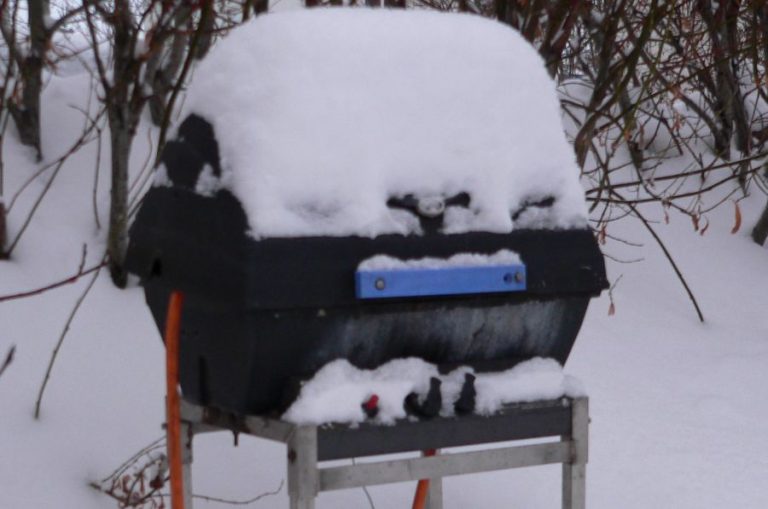What Is the Minimum Outdoor Temperature for a Hot Tub
Getting into your hot tub after the day's work is one of the most soothing and enjoyable things to do on a cold day. Tell me what better way to rest from all the stress and strains of the day other than soaking yourself in that soothing warm water of your hot tub. While winter remains one of the best times of year for hot tubbing -at least according to most people- it also brings along specific challenges for hot tub owners. However, one question remains- what is the minimum temperature that a hot tub should have? Just how cold is too cold, or should it be?
What Is the Minimum Outdoor Temperature for a Hot Tub?
There is no fixed minimum outdoor temperature for your hot tub, and you do not have to be afraid the hot tub will freeze. Only during a long power outage, you have to be very careful, and you do have to take care that all parts and pipes that have water inside are kept above freezing. If the temperature gets low during winters, it is advisable to use a hot tub designed for such low temperates with additional insulation.

Contents
- 1 Should you use your hot tub in the winter?
- 2 Why Is The Hot Tub Temperature Important?
- 3 Hot Tub Temperature Basics
- 4 Minimum Temperature Basics for the Winter Season
- 5 Hot tub winter tips
- 5.1 – Open jets and waterfall lines
- 5.2 – Check if your cover is working properly
- 5.3 – Close the Cover Corectly
- 5.4 – Turn the air controls off
- 5.5 – Do not refresh the water
- 5.6 – Wear a hat
- 5.7 – Wear Slippers
- 5.8 – Be careful removing the snow on the cover
- 5.9 – Regular maintenance
- 5.10 – Minimum water temperature
- 6 Heat loss during winter usage
- 7 Wood-fired hot tub in the fall, winter, or spring
- 8 How Cold is Too Cold?
- 9 If you do not use your hot tub in the fall, winter, or spring
- 10 Final Remarks
Should you use your hot tub in the winter?
You should use your hot tub during the winter. There is nothing nicer than having a warm bath outside in the cold winter when snow is falling. For many people, it is even their favorite time to use it. Your hot tub is also built to be used during the winter. When correctly maintained, a normal water level, and the heater working, there is no significant danger that your pipes will be freezing. Do not set the water temperature higher than 104° F, do not stay in the water too long, and use proper clothing between your house and the hot tub.
– What about the hot tub temperature in the winter?
Just as your hot tub vary in sizes, add on accessories, capacities or strength, and optional features, the temperature of the tub is a very personal preference that often differs from one individual to another. However, there exists a minimum safe temperature of 78.8°F, which is generally accepted by many people. While many people prefer the temperature range of 80°F and above, different factors such as medical conditions, drug prescription use, alcohol intake, and the age group of users can largely affect these suggested or preferred hot tub temperatures. That being said, there's still a lot to know about the water temperature of hot tubs, their safety, and their general benefits. If you wish to learn more about your hot tub, don't look too far. In the rest of this article, we will carefully break it down and examine all that there is to know about your hot tub temperature and more.
Why Is The Hot Tub Temperature Important?
Typically, the human body rests at an average temperature of 98.6 degrees Fahrenheit, so immersing oneself in a hot tub with a temperature higher than this is why it feels so relaxing and pleasing. The heated water is so soothing that it will help relax your muscles after a long day of work. However, it is equally important to think about safety while using the hot tub.
If you spend too much soak time in hot water, your body temperature automatically rises, which can lead to overheating, drowsiness, fainting, and an eventual heat stroke if you fail to get out of the water on time. These conditions are even more critical in children and older people whose bodies are not as resilient to the high-temperature level of the water. On the other hand, immersing yourself in water that is too cold can also lead to several health conditions, such as severe cold, numbness, and hypothermia. This is why making use of the right temperature is very crucial at any time of the year. Asides from being harmful to your health, if the tub is too cold, the water flowing through the pipes will freeze. If the water freezes, it automatically expands and causes the pipes to expand also, which can cause a lot of damage to all the internal systems of your hot tub.
Hot Tub Temperature Basics
Just like its rolling waters and that unique chance to hang out or kick it with friends and family, the heat of your hot tub remains one of its major attractions and the reason why most people are drawn to it. However, there are times when you decide to lower the temperature and enjoy a cool bath, especially in the summer. What then is the minimum outdoor temperature of your hot tub? To answer your question, the minimum outdoor temperature of a hot tub is within the range of 78.8°F. The only time that many people might consider setting the temperature as low as 78 degrees would probably be in the summer when the hot tub is being used to cool off rather than stay warm. In the winter, it is customary to go for higher temperatures, as this is incredibly soothing and relaxing to the body.
Minimum Temperature Basics for the Winter Season
As stated earlier, one of the most common questions asked by many hot tub owners is, "what minimum temperature should my hot tub be set at?" Keep in mind that whatever temperature you choose to set your hot tub, it must not go below 78.8°F. Usually, most hot tubs that are being manufactured are automatically designed to heat up to 100°F when they're powered on. The heater of your hot tub is a simple device. Just by flicking the switch, you can pick any temperature that you want. Heating then begins after a while before it finally regulates the particular temperature that you choose. Using this as a starting point, you can either choose to turn the temperature up or down until you find a range that's just right for you.
During the summer, most people tend to reduce the temperature of their hot tubs to an unsafe level due to the hot weather. However, this can be dangerous as your body temperature might drop too low, causing severe health conditions, and in some extreme cases, death. In this case, there are some simple steps to follow:
Be conservative. Whenever it is extremely cold outside, ensure that your water temperature does not go below 78.8°F, and minimize your soak time to 15 minutes- and that's for a healthy adult with no medical conditions. Also, you need to know your body and what it can withstand.
Hot tub winter tips
– Open jets and waterfall lines
Open the jets and waterfall lines in your Hot tub. Those small lines have a higher chance of freezing when there is no water running through them. When they are open, warm water will run through them, and they can not freeze.
– Check if your cover is working properly
Before the winter season starts, it is good to check your cover. Does it fit tightly, is it still waterproof, is the insulation up to the job? The most significant energy loss occurs when the cover is not working fine or is in bad shape. Investing in a high-quality cover will save you money in the long run, as you need less electricity to heat the water.
– Close the Cover Corectly
Make sure that your cover is closed correctly. When not closed correctly, the insulation will be less efficient, and a lot of heat can escape. This means the heater has to work harder to maintain the correct temperature.
– Turn the air controls off
Turn the air controls off when you are not using your hot tub. The air controls push fresh air through the water, but particularly in winter, this will lower the water temperature. This means the heater has to work harder to maintain the correct temperature.
– Do not refresh the water
It is not a good idea to change the water in your hot tub during the winter. The cold outside temperature increases the risk of your pipes freezing during the filling period. The new water you add is cold, and it takes time before it is heated. If you need to change the water, you could do it in steps, draining some water and refilling it. While the result is not as good as completely draining and filling, the freezing risk is much smaller.
– Wear a hat
When the temperature is really low, it can be a good idea to wear a hat.
– Wear Slippers
It is good to wear slippers or sandals to keep your feet warm and not stop tracking debris and dirt into the water.
– Be careful removing the snow on the cover
Take great care if you remove the snow that is on the cover with a shovel. It is easy to rupture the material on the cover. Plastic is less flexible at low temperatures.
– Regular maintenance
Maybe you use your hot tub less than during other seasons due to bad weather, but do not forget to maintain your hot tub. Check the water level regularly. Is it clean? And are the needed chemicals added?
– Minimum water temperature
It is advised not to lower the water temperature below 90 F. You can experiment with what temperature you like best. Most people prefer it to be higher than their body temperature (98.6 F). The lower the water temperature, the less time it takes to start freezing in case of a power outage.
Heat loss during winter usage
The most significant heat loss occurs when the cover is not closed correctly, or it is not insulated enough. Another big reason for heat loss is direct ground contact. Some hot tubs use an additional base pan. If your hot tub does not have one, you could purchase one. Raising the hot tub slightly from the floor can also help, but make sure it can handle the full weight, including the water and people.
Wood-fired hot tub in the fall, winter, or spring
Can you use a wood-fired hot tub in the winter? Yes, you can. But it would be best if you prepared yourself well. Where will the water come from as your outside tabs will probably be closed for the winter?
To fill the tub, light the fire, and add water slowly in batches to not freeze. Keep in mind that warming up the water in the winter will take more time and more wood. The starting temperature of the water will be lower, and due to the colder ambient temperature, there will be much more heatless. When the tub has reached the correct temperature, you have to keep the fire going to keep the tub and heater from freezing.
When you are done, and the fire is out, you must drain the heater. If your hot tub is insulated, the water will be kept from freezing for some time, but the heater is typically not insulated, and the pipes will freeze very quickly. If you want to keep the water in the tub for the next day, you have to use plugs or valves to close the pipes to the heater and drain them. The next day you can light the fire and remove the plugs (or open the valves).
If you want to keep the water from freezing for a more extended period, you could also look at a backup electrical heater (Aux heater). They will not hold the hot tub at the operating temperature, but they will keep the water from freezing.
How Cold is Too Cold?
If the summer heat has been getting to you, it is normal to not feel like taking a hot bath in your hot tub. Sure, hot water is relaxing, but after several weeks of constantly high temperatures, jumping into cool and refreshing water is probably the only thing on your mind. In case you're wondering if you can turn your hot tub cold, the short answer is yes. In this case, all you need to do is turn down the temperature on the digital display or disconnect the heater completely. Once the temperature of your hot tub has cooled down, you can now proceed to take that cool and relaxing bath, as you have pictured.
While soaking in a cold tub is relaxing, it is important to minimize your soak time. Coldwater is known to accelerate hypothermia, as the loose body heat 20 times faster in cold water. This condition can negatively affect your organs such as the heart, lungs, brain, and other vital organs of your body. Hence, the water temperature in your hot tub should never go below 78.8°F, which is the appropriate minimum limit recommended by the Centers for Disease Control (CDC) and the Consumer Product Safety Commission (CPSC).
Most hot tubs available on the market today usually come with pre-installed safety settings that ensure that the water does not go below this temperature. While it is expected for most people to want their water temperature to be colder than their body temperature during the summer, it is crucial that you do not let it go below the "safe" limit (usually 78.8°F). Simultaneously, the cooler your water temperature is, the closer it is to freezing temperatures. Hence, people with certain health disorders, people with different tolerance to cold, and specifically children, should be given special attention.
If you do not use your hot tub in the fall, winter, or spring
IF you do not use your hot tub during the winter, make sure you winterize it correctly. All the water must be drained from the system, so no pipes or other parts can freeze and create a lot of damage. It is Important to drain the water from the blower and filters. Make sure they are all dry before the temperature drops.
Final Remarks
Now that you already know deciding the right temperature for your hot tub can be quite tricky. Not only would you have to balance your personal preferences with that of other users in your home, but you'd also have to consider what is deemed as safe by health organizations. This is why you must always invest in a quality hot tub to prevent unnecessary heat loss that may cause damage to your equipment. We hope that this article has been helpful to you. Good luck.






